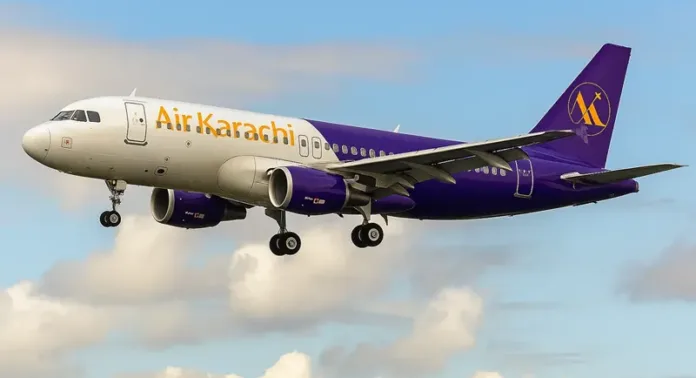The Article Tells The Story of:
- $17.6M Backing by 100 Businessmen: A Karachi-based consortium funds the airline to break PIA’s monopoly.
- COMAC, Boeing, or Airbus? Air Karachi considers three aircraft suppliers, but leans toward China’s cheaper alternative.
- Domestic Flights First, Global Later: The airline will fly locally for a year before launching international operations.
- Can Chinese Planes Shake Boeing and Airbus? COMAC’s C919 offers low-cost, high-tech features that may disrupt global aviation.
Air Karachi Aims for Lift-Off with COMAC Planes
Squaredtech.co confirms that Air Karachi, Pakistan’s newest private airline project, is actively working with China’s Commercial Aircraft Corporation (COMAC) to acquire airliners for its initial flight operations. According to Chairman Hanif Gohar, the airline is also exploring deals with Boeing and Airbus, but COMAC is currently leading the negotiations.

Backed by 100 Pakistani business leaders who pooled Rs5 billion ($17.6 million) in seed money, Air Karachi represents a major private initiative to reshape the country’s aviation sector. The airline was launched in November 2024 and has already secured a Regular Public Transport (RPT) license from the Pakistan Civil Aviation Authority (CAA) as of June 2025.
Gohar told media outlets that Air Karachi’s first operations will focus on domestic routes using at least three aircraft. The fleet will later expand to seven planes as the company prepares for international operations after meeting the CAA’s one-year domestic flight requirement.
COMAC’s Edge: Low Cost, High Tech — A Direct Threat to Boeing and Airbus
Squaredtech sees COMAC’s C919 as a potential game-changer in aviation. While Boeing and Airbus dominate global aircraft sales, Chinese manufacturers are offering planes with comparable specs at nearly 50% lower leasing and acquisition costs.
Gohar explained that COMAC aircraft offer cost-efficiency, giving Air Karachi a chance to slash domestic ticket prices by up to 40%. This is a strategic move to attract price-sensitive passengers and disrupt a market long dominated by legacy carriers and struggling national airlines like PIA.
Here’s what the Chinese technology brings to the table:
✅ 1. Cost-Effective Manufacturing
The C919 aircraft is built with affordability in mind. Manufacturing costs are significantly lower than Airbus A320 or Boeing 737 models. Leasing rates are also cheaper, which allows airlines to save millions annually.
✅ 2. Fuel-Efficient Engines
COMAC aircraft use modern LEAP-1C engines co-developed by General Electric and Safran, offering high fuel efficiency and reduced carbon emissions. This makes the planes environmentally competitive without inflating operational costs.
✅ 3. Advanced Avionics
Chinese airliners now come with digitally integrated cockpit systems, helping reduce pilot workload and improve flight safety. These avionics are becoming comparable to Western systems at a lower price point.
✅ 4. Simple Maintenance Architecture
COMAC’s aircraft are designed for easy part replacement and simplified maintenance cycles. That means fewer delays and lower downtime costs—critical for new airlines trying to stay profitable.
✅ 5. Local Support Ecosystem
Gohar shared that flight simulators and spare engines will be imported to Pakistan to support the fleet and fast-track pilot training. Initially, Chinese pilots will fly the planes while Pakistani crews undergo training. This hybrid model allows for immediate operations while building local capacity.
Will COMAC Planes Disrupt Global Aviation?
At Squaredtech, we believe that Air Karachi’s decision could have long-term implications beyond Pakistan. Here’s how COMAC’s presence may threaten the Boeing-Airbus duopoly:
🔹 Disruption in Emerging Markets
If Air Karachi succeeds using COMAC aircraft, other budget carriers in Africa, Southeast Asia, and the Middle East may follow suit. The cost difference alone makes Chinese aircraft appealing to startup airlines and low-cost operators.
🔹 Price Pressure on Airbus and Boeing
COMAC’s competitive pricing could force Boeing and Airbus to lower prices or offer better leasing deals to maintain their share in price-sensitive markets.
🔹 Political and Regulatory Shifts
Although Western countries remain cautious about Chinese aircraft due to certification issues, Pakistan’s Civil Aviation Authority has raised no objections. If more regulators follow suit, COMAC could start winning approvals in other regions too.
🔹 Technology Catch-Up
While Boeing and Airbus still hold advantages in experience and global infrastructure, COMAC is quickly closing the gap. Its C919 project benefits from partnerships with global suppliers like Honeywell, GE, and Michelin—ensuring quality doesn’t lag behind price.
Why Air Karachi Matters to Pakistan’s Aviation Sector
Squaredtech notes that Air Karachi’s business model is inspired by Air Sial, another privately funded airline launched by industrialists from Sialkot. Like Air Sial, Air Karachi aims to bring efficiency and accountability to a sector long marred by state mismanagement.
With Pakistan International Airlines (PIA) facing privatization and suffering operational losses, private carriers are stepping in to meet growing domestic demand.
Air Karachi’s private funding, modern technology, and cost-conscious strategy could:
- Break monopolies on major routes.
- Introduce modern fleets with global standards.
- Force competitors to cut ticket prices or upgrade service.
- Create jobs in aviation, engineering, and logistics.
Final Thoughts from Squaredtech
Air Karachi is a bold bet on new technology and private capital. Its early talks with COMAC—and parallel negotiations with Boeing and Airbus—show that the airline wants the best deal with the fastest turnaround.
By choosing to start with Chinese aircraft, Air Karachi is testing whether emerging-market carriers can challenge aviation norms using cheaper, efficient, and modern alternatives. The results could reshape not just Pakistan’s skies—but global flight dynamics.
We’ll be watching closely at Squaredtech.co as this story unfolds.
Stay Updated: Tech News


